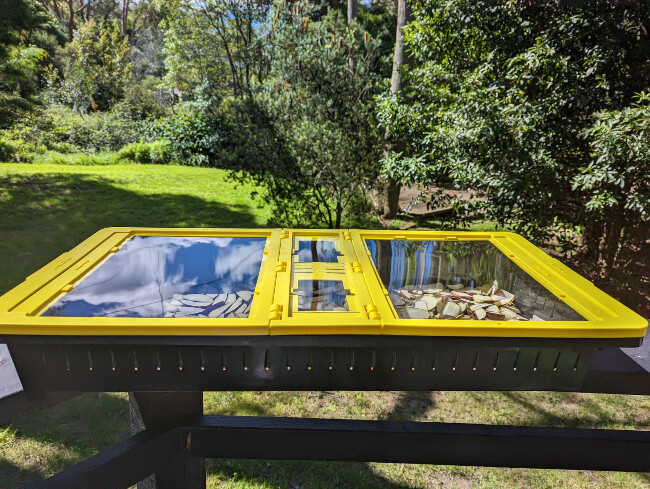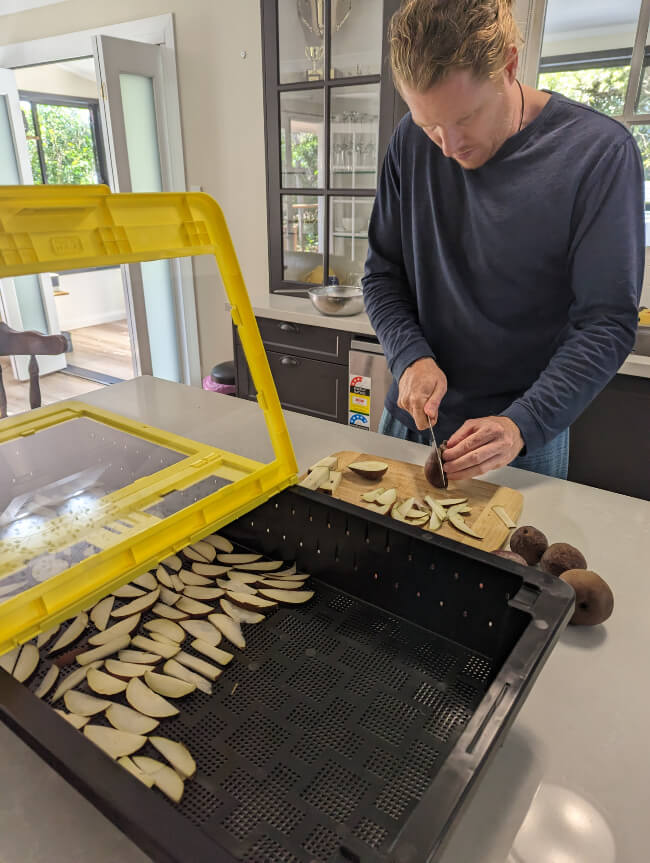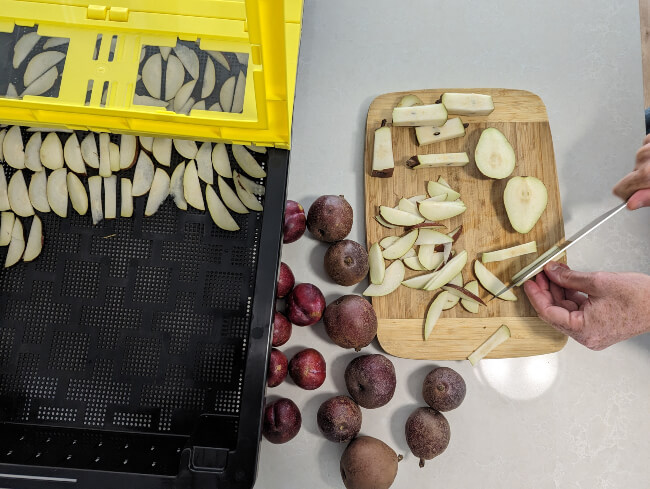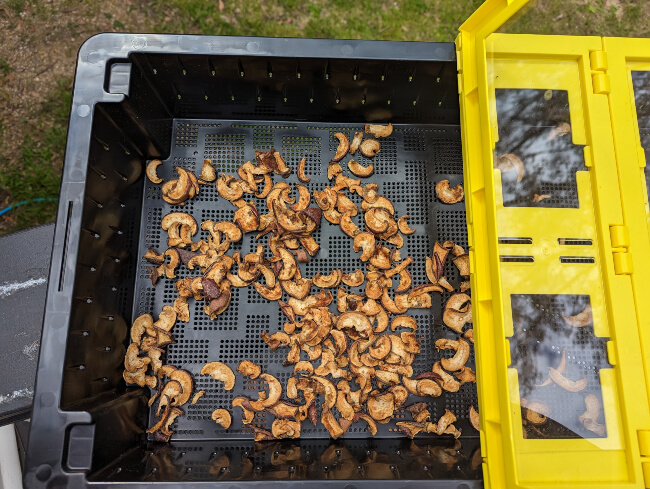Dehydrating fruit and vegetables is an incredible way to store your harvests for longer while maintaining all of their nutrients, fibre, and vitamins. Unlike cooking and preserves, dehydrating removes moisture to prevent rot, meaning there’s no need to add sugar, salt, vinegar, or any nutrients.
The Dehytray is a brilliant innovation in this area, as it removes the need for expensive, and energy-inefficient dehydrating units, that take up kitchen space, and cost an arm and a leg to operate with electricity.
We’ve tried out this brilliant new piece of food preservation kit, and broken down how to use it, what you can prepare with it, and just exactly how the Dehytray Solar Dehydrator works.
More...

Nathan Schwartz of Aussie Green Thumb with a Dehytray Solar Dehydrator
What is the Dehytray Solar Dehydrator?
The Dehytray Solar Dehydrator is a simple tool that harnesses the heat of the sun and ventilates food to allow moisture to be removed slowly and energy efficiently. This method of dehydration is slower than electric dehydrators, but it produces much better results, which we’ve found keep for longer too.

In essence, it’s a pretty simple bit of kit. It’s a plastic box with ventilated sides and separators (so you can process a few things at a time), and a clever transparent lid that maximises the sun’s heat to dry out sliced fruit in a matter of days.
How does the Dehytray Solar Dehydrator work?
The unit is basically a sturdy black plastic box, with a simple clear lid. Both are ventilated and designed to keep heat in and let moisture out. That basic innovation, used for all sorts of solar heating and passive heating technologies in the past, is a revelation in food dehydration, despite being so simple on the surface.
While most juicy fruits like strawberries, apples, or pears, will take about 6-7 days to dehydrate fully, other things like kale, carrots, or beets are a little quicker. We’ll take a look at what you can dehydrate in more detail later.
What Do You Get in the Dehytray Solar Dehydrator Kit?
The package includes one Dehytray dehydrator (but you get a decent discount when you buy two, three, or four units), a detailed instruction manual, durable food scraper to remove any sticky sugary residue (though we’ve only really found this to be necessary when using berries as the higher liquid content can seep out during drying), and a hygrometer to measure humidity in the box.
The hygrometer is useful, but in most cases, you’ll be able to see and feel when your food is dry. Like any hygrometer, it will be affected by relative humidity outdoors on any given day, so we tend to use it as an indication rather than a rule.
What to Dehydrate Using Your Dehytray?

Nathan slicing red D'Anjou pear for dehydration
We’ve dehydrated our own veggies for years here, but there are some things that just won’t work. Apples and pears are a great place to start, but as you get more confident, the Dehytray allows you to dehydrate even the juiciest fruits.
For example, a basic three-tier dehydrator will be great for crisp veggies, but soft fruits are always a messy business. The Dehytray continues drying fruit out and will leave a very small amount of sugary residue on the base.


Get Your Free Guide:
Master Growing Australian Natives eBook
A Must Have Complete Guide for Every Australian Garden
Get Your Free Guide:
Master Growing Australian Natives eBook
A Must Have Complete Guide for Every Australian Garden
So, in essence, if you can slice it, you can dehydrate it with the Dehytray. For some inspiration though, check out the sort of stuff we’ve been dehydrating for some exciting additions to your kitchen cupboard.
Best Fruit to Dehydrate
You can’t go wrong with apples and pears, but the thing we’ve had the most success with using solar dehydration has to be tomatoes. Sun-dried tomatoes (or cheat’s oven-dried tomatoes) are a faffy thing to make, and leave you with loads of washing up.
By slicing your tomatoes down the middle and leaving them out in the Dehytray for about a week, you’ll have gorgeously sugary, rich, tomatoes in hackle the time you’d get them naturally, and with much more retained nutrition.
Berries and currants dry beautifully too, with a sticky, chewy texture. Blackcurrants are my personal favourite, as they dry into the most deliciously sweet, but tangy treats, and last for months in an air-tight jar.

Best Veggies to Dehydrate
Beetroot, carrots, and parsnips are the most commonly dehydrated veggies, because root vegetables tend to lend themselves to dehydration quite well, and crisp up – especially if you slice them super-thin using a mandolin.
However, if you want something a little bit different, try spiralizing a courgette before dehydrating it. You’ll get the most wonderfully light crispy twiglets that can be broken up for a chewy crunch over salads, or used as croutons as a garnish for thick soups in winter.
Even veggies that stroke well like onions and garlic are a revelation in the Dehytray, as they can be completely dehydrated, and even powdered if you leave them for long enough, to make a full-flavoured seasoning you can use all year round.
Best Herbs to Dehydrate
The key to preserving flavour in dried herbs is time (not thyme). The slower the process, and the gentler the heat, the more flavour you’ll be able to keep in your herbs, and the fresher they’ll taste when you cook with them.
Any herb, whether it’s the thick rhizomes of turmeric and ginger, or the soft leafy greens of coriander and thyme, you can dry it effectively and efficiently using a Dehytray.
Here is a list of growing guides for some of the fruits and vegetables mentioned above:
How to Use Dehytray Solar Dehydrator

Nathan all set with his Dehytray
Start by slicing your fruit and vegetables up as finely as possible. For some, that means using a mandolin for wafer-thin slices, for others (tomatoes and berries) slicing in half is the best option as you can place them skin-side down so the liquid parts dry out slower and retain more flavour.
Once you’ve prepared everything for dehydrating, use the separators to create sections for each fruit, then place them in a single layer across the base (this is essential, as piling them up will slow down the process and create a stuck-together mess at the end)
And finally, place the lid on, and position your Dehytray somewhere bright, in full sun, and away from any running water to reduce unnecessary humidity. Then just wait. For some foods it can take up to a week, for others they’ll be ready to eat or store after just 2-3 days.
Dehytray Solar Dehydrator Frequently Asked Questions

How long does it take to dehydrate food in the Dehytray?
With good summer weather, it can take less than 24 hours to dehydrate some foods, but for most foods, in average conditions, it will take between two and three days. For juicier fruits with more moisture, like apples, expect to leave them for about 4 days to fully dehydrate, or 6 days in cooler weather.
Do solar dehydrators work?
Solar dehydrators work effectively and efficiently but are particularly good at drying leafy vegetables and herbs. When it comes to drying moist fruit and veggies, they take a little longer but are still an effective tool.
What are the disadvantages of a solar dehydrator?
Solar dehydrators take time and require direct sun to work. While they do work in overcast conditions, and even through a rainy week, they are much slower in those conditions, and therefore less reliable in commercial settings, or in haste, than electric dehydrators.
Have Fun Creating Delicious Food Using the Dehytray Solar Dehydrator
We tested out the solar dehydrator towards the end of summer, and have been using it right through autumn, and have found it works just as well in pretty much all conditions. Obviously, it’s faster in summer than in winter, but even wet, rainy, overcast days of about 16-17° won’t stop it from working.
If you’re after an easy, compact, dehydrator that’s fun to use, creates delicious food, and helps you store your harvest for longer, there’s nothing else that even comes close to competing with the Dehytray solar dehydrator.
Published on April 20, 2023 by Nathan Schwartz
Last Updated on February 25, 2024





do you know where the dehytray can be purchased in Australia?
Hi Deb,
You can go to their website and order one but it currently comes from the US. I would recommend emailing Luke at [email protected] he is the Australian representative and will be able to help you out. They are in the process of getting distributors in Australia.
Best regards,
Gary